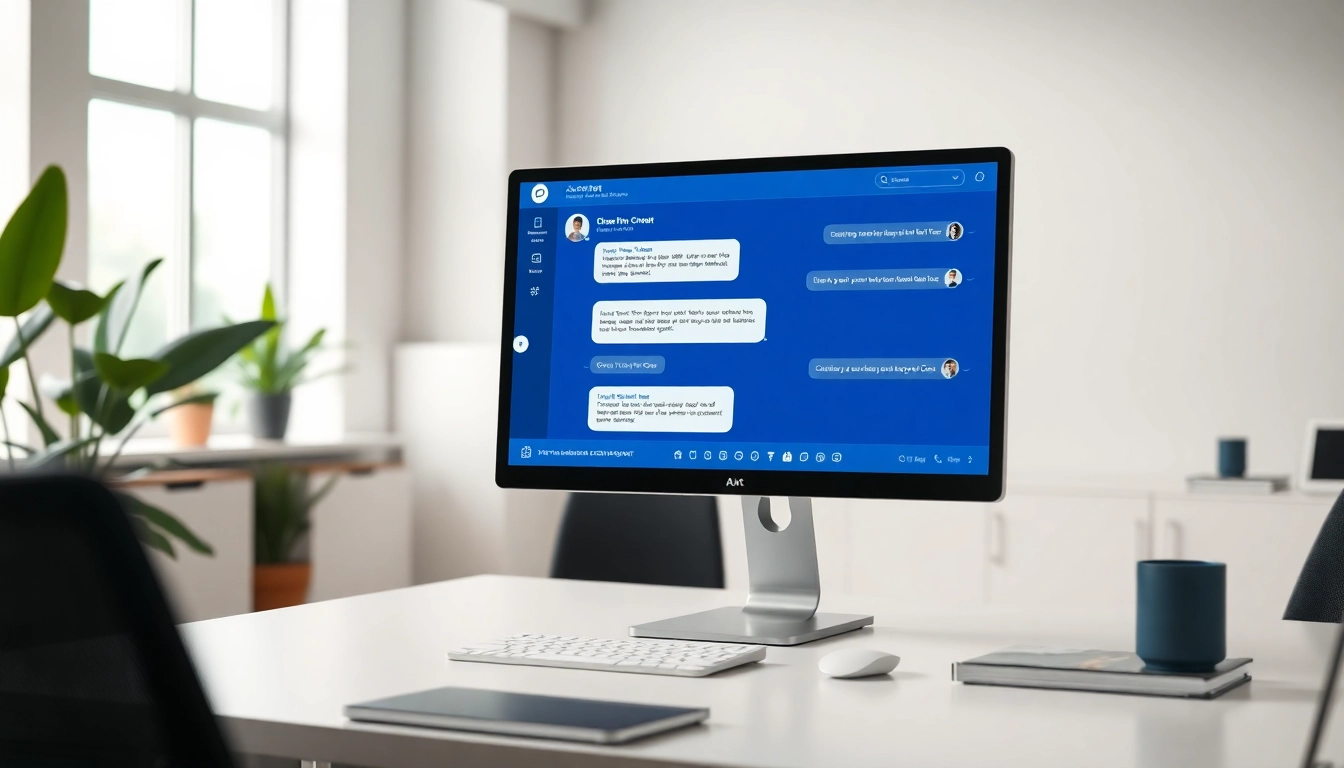Understanding Chatgpt Chatbots
What is a Chatgpt Chatbot?
A chatgpt chatbot is a conversational agent powered by OpenAI’s GPT (Generative Pre-trained Transformer) model, designed to facilitate engaging, human-like interactions through chat interfaces. These chatbots utilize advanced natural language processing (NLP) algorithms to comprehend and respond to user inquiries in a conversational manner. Unlike traditional chatbots that rely heavily on pre-set rules and scripts, Chatgpt chatbots exhibit a degree of learning and adaptability, allowing them to understand context, nuance, and user intent more deeply.
Key Features and Benefits
Chatgpt chatbots offer a myriad of features and benefits that make them a compelling choice for businesses looking to enhance their customer interaction capabilities:
- Natural Language Understanding: These chatbots can interpret user input with high accuracy, making interactions feel more seamless.
- 24/7 Availability: Unlike human agents, chatbots are available around the clock, providing instant responses to inquiries at any time.
- Cost-Effectiveness: By automating responses to common questions, businesses can significantly reduce operational costs.
- Scalability: As businesses grow, chatbots can handle a larger volume of customer interactions without needing additional resources.
- Data Collection: Chatgpt chatbots can gather valuable data on customer preferences and behavior, enabling businesses to tailor their services greatly.
Common Use Cases in Business
Chatgpt chatbots find application in various business sectors, streamlining operations and improving customer engagement:
- Customer Service: Providing instant answers to frequently asked questions, handling inquiries, and resolving complaints.
- Sales Support: Assisting customers in finding products, guiding them through the purchase process, and upselling related items.
- Lead Generation: Qualifying leads through initial conversations and gathering contact information for future marketing efforts.
- Booking and Reservation: Automating appointment scheduling, ticket bookings, and other reservations for businesses in travel and hospitality.
- Education and Training: Offering personalized learning experiences and answering student queries in educational institutions.
Implementing a Chatgpt Chatbot
Choosing the Right Platform
The first step in implementing a Chatgpt chatbot involves selecting the appropriate platform. Factors to consider include:
- Ease of Use: Look for platforms that offer user-friendly interfaces and drag-and-drop features for designing chat flows.
- Integration Capabilities: Ensure the platform can integrate seamlessly with your existing systems such as CRMs and databases.
- Customization Options: Choose platforms that allow for brand-specific customization in terms of aesthetic and tone of voice.
- Support and Resources: Evaluate the availability of customer support and documentation, which can be crucial during the setup process.
Integrating with Your Existing Systems
Once you have selected a platform, the next step is to integrate the chatbot with your existing systems. This includes:
- CRM Integration: Syncing the chatbot with your customer relationship management (CRM) tools allows for a unified view of customer interactions.
- Website Integration: Implementing the chatbot on your website or mobile app ensures accessibility for users.
- Data Feeds: Connecting the chatbot to existing data feeds can enhance its ability to provide real-time information.
Design Best Practices for User Interaction
Creating a user-friendly interaction experience is critical. Consider the following design best practices:
- Clarity: Use clear and concise language to ensure the chatbot’s responses are easily understood.
- Personalization: Tailor responses based on user data to create a more relatable interaction.
- Quick Responses: Aim for quick loading times and responses to keep users engaged.
- Use of Emojis: Incorporate emojis to make interactions feel more lively and human-like.
Measuring Success of Your Chatbot
Key Performance Indicators (KPIs)
To assess the success of your chatbot, establishing key performance indicators (KPIs) is essential. Key metrics to track include:
- User Engagement: Measure the average interactions per user and frequency of return visits.
- Resolution Rate: Calculate the percentage of inquiries resolved without human intervention.
- Response Time: Monitor the average time taken to respond to user inquiries.
- User Satisfaction: Conduct surveys post-interaction to gauge user satisfaction levels.
Tools for Tracking Performance
Utilize various tools to track the performance of your Chatgpt chatbot:
- Analytics Platforms: Implement analytics tools like Google Analytics to monitor user behavior and interaction statistics.
- Bot-Specific Analytics: Use analytics features provided by the chatbot platform to gain insights tailored to chat interactions.
- Feedback Tools: Utilize survey tools to collect user feedback on their experiences with the chatbot.
Gathering User Feedback for Continuous Improvement
Feedback from users is crucial for the continuous improvement of your Chatgpt chatbot. Here’s how to effectively gather and utilize feedback:
- Post-Interaction Surveys: Send brief surveys at the end of each chat session to assess user satisfaction.
- Monitor Conversations: Review transcripts of interactions to identify areas for improvement.
- Incorporate Regular Updates: Regularly update your chatbot based on user feedback and performance metrics to enhance user experience.
Advanced Strategies for Chatgpt Chatbots
Utilizing Machine Learning for Better Responses
Implementing machine learning techniques can enhance the response quality of your Chatgpt chatbot. AI can:
- Learn from Interactions: Analyze past conversations to improve understanding and response strategies.
- Predict User Needs: Employ predictive analytics to anticipate user questions based on historical data.
- Self-Training Models: Utilize self-training models that adapt and improve over time based on engagement patterns.
Personalization Techniques
Personalization can drastically improve user interaction with your chatbot. Consider the following personalization techniques:
- User Profiling: Create profiles based on user data and past interactions to tailor the chatbot’s responses.
- Dynamic Content: Use dynamic content that changes based on user preferences, previous conversations, and context.
- Behavior Triggers: Implement triggers that initiate specific responses based on user behavior, such as repeat visits or previously unresolved questions.
Integrating Multilingual Support
In a global marketplace, offering multilingual support can greatly enhance your chatbot’s effectiveness:
- Local Language Support: Ensure that your chatbot can converse in multiple languages to cater to a diverse audience.
- Cultural Awareness: Implement cultural nuances in conversation to resonate well with users from different backgrounds.
- Language Detection: Deploy language detection algorithms to automatically identify and switch languages during interactions.
Future Trends in Chatgpt Technology
Emerging Technologies and Innovations
The future of Chatgpt technology is bright, with innovations constantly emerging. Some trends to watch include:
- Advanced NLP Techniques: Continued advancements in NLP will create even more contextual and intelligent chatbots.
- Voice-Activated Chatbots: The rise of voice technology will lead to more voice-activated chatbots that integrate with home devices.
- Cross-Platform Support: Future chatbots will seamlessly interact across multiple platforms, providing a cohesive experience across web, mobile, and social media.
Impact on Customer Service and Engagement
Chatgpt chatbots are set to redefine customer service and engagement in several ways:
- Enhanced Responsiveness: Businesses will be able to respond to customer inquiries in real-time, improving satisfaction rates.
- Proactive Customer Engagement: Chatbots will not only respond to questions but can also initiate conversations based on user behavior.
- Deeper Customer Insights: Companies will gain more profound insights into customer preferences, allowing for better-targeted marketing strategies.
Preparing for the Future of Chatbots
As chatbots continue to evolve, businesses must prepare to adapt by:
- Investing in Technology: Staying updated with the latest chatbot technologies to leverage their full potential.
- Training Staff: Ensuring that employees are educated on how to effectively use and manage chatbot functionalities.
- Adapting Business Strategies: Developing business strategies that incorporate chatbots as a core element of customer interaction and service delivery.



